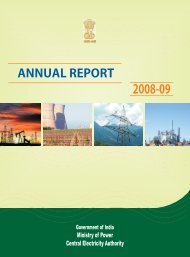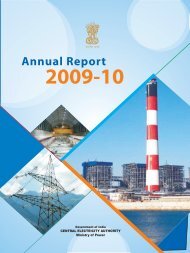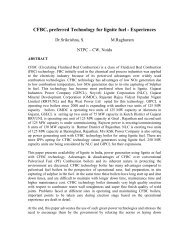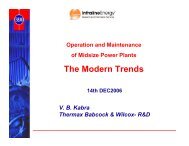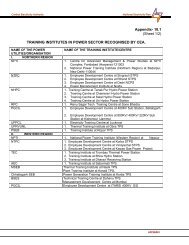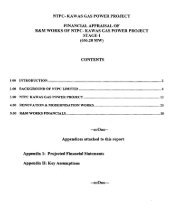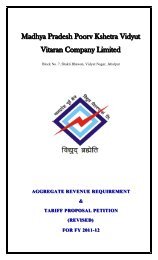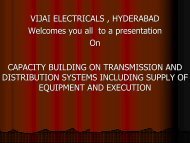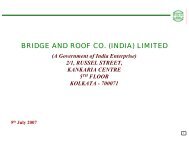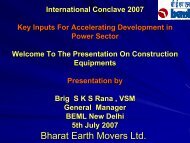Presentation on Case I & Case II Bidding Projects ... - Infraline
Presentation on Case I & Case II Bidding Projects ... - Infraline
Presentation on Case I & Case II Bidding Projects ... - Infraline
Create successful ePaper yourself
Turn your PDF publications into a flip-book with our unique Google optimized e-Paper software.
<strong>Case</strong> I & <strong>Case</strong> <strong>II</strong> <strong>Bidding</strong> <strong>Projects</strong>:<br />
Evaluating Competitive Regime<br />
S. C. Manocha<br />
CEO & Whole Time Director (LITL -EPC)
REFORMING POWER SECTOR IN INDIA<br />
Policy acti<strong>on</strong>s<br />
• EA 2003 introducing<br />
– N<strong>on</strong>-discriminatory open<br />
access transmissi<strong>on</strong><br />
– Sec 63 - ERCs to follow<br />
competitive bidding process<br />
– Sec 79(2) - CERC to advise GoI<br />
<strong>on</strong> promoting competiti<strong>on</strong><br />
– Secti<strong>on</strong> 60 – C<strong>on</strong>trolling<br />
abuse of market power<br />
• Competitive <strong>Bidding</strong> Guidelines<br />
• Nati<strong>on</strong>al Tariff Policy<br />
Evolving market structure in power sector<br />
Nati<strong>on</strong>al<br />
‘Tariff’<br />
Policy<br />
• Open access<br />
• Competitive bidding<br />
Comp. <strong>Bidding</strong><br />
Guidelines<br />
Electricity<br />
Act 2003<br />
Open Access, Sec<br />
63/ Secti<strong>on</strong> 79( 2)/<br />
Sec 60<br />
C<strong>on</strong>testable<br />
Price<br />
Discovery<br />
Competitive<br />
new<br />
generati<strong>on</strong><br />
Possible Wholesale /<br />
Retail Competiti<strong>on</strong>
Need of Electricity Act, 2003<br />
Inability to meet the growing demand.<br />
Poor quality of supply- low voltage, grid instability<br />
Vertically Integrated SEBs<br />
Only SEBs entitled to buy or sell electricity<br />
Generati<strong>on</strong> and Supply largely owned by state or central sector companies<br />
Inefficiencies leading to enormous losses in the system<br />
Private participati<strong>on</strong> almost n<strong>on</strong>-existent<br />
Generati<strong>on</strong> needed license.<br />
No significant participati<strong>on</strong> in Transmissi<strong>on</strong>, distributi<strong>on</strong>.<br />
Cost plus model followed by generators and distributors.<br />
Power traded through L<strong>on</strong>g Term PPAs of 25 years.<br />
Large captive capacities come up due to c<strong>on</strong>tinued poor and inadequate<br />
supply<br />
Complete absence of competiti<strong>on</strong>
Electricity Act, 2003<br />
‣ C<strong>on</strong>solidates laws of electricity relating to generati<strong>on</strong>, transmissi<strong>on</strong>, distributi<strong>on</strong><br />
and trading of electricity.<br />
‣ Creates envir<strong>on</strong>ment c<strong>on</strong>ducive for development of electricity industry and<br />
Introducti<strong>on</strong> of competiti<strong>on</strong> in the Sector.<br />
‣ Formati<strong>on</strong> of Nati<strong>on</strong>al Electricity Policy and Nati<strong>on</strong>al Tariff Policy.<br />
‣ Open Access for Transmissi<strong>on</strong> /Distributi<strong>on</strong> Systems allowed.<br />
‣ De-licensing of power generati<strong>on</strong>.<br />
‣ Trading of electricity permitted.<br />
‣ Liberal provisi<strong>on</strong>s for captive power generati<strong>on</strong>.<br />
‣ Rural generati<strong>on</strong> and distributi<strong>on</strong> freed from licensing.<br />
‣ Expanded role for the Regulatory Commissi<strong>on</strong>s – tariff determinati<strong>on</strong> etc<br />
‣ Role of CEA reduced.<br />
‣ Envisages unbundling of transmissi<strong>on</strong> and distributi<strong>on</strong>.<br />
‣ The Regulatory Commissi<strong>on</strong> to promote development of market including trading.
EA 2003 sets the stage for Competiti<strong>on</strong><br />
<br />
<br />
<br />
<br />
<br />
<br />
Allows multiple generators to come up and compete<br />
Allows larger c<strong>on</strong>sumers to choose supplier<br />
Prescribes competitive procurement of power <strong>on</strong> l<strong>on</strong>g term<br />
Aims to create a Nati<strong>on</strong>al Market via compulsory open access<br />
Policy framework assures<br />
‣ Reas<strong>on</strong>able and stable returns <strong>on</strong> investments<br />
‣ Well defined Regulatory mechanisms<br />
Makes governments resp<strong>on</strong>sible for providing Power <strong>on</strong> demand
How Does Competiti<strong>on</strong> Help?<br />
‣ Allow multiple participants to compete with each other to<br />
• Provide High Quality at Low Prices<br />
‣ Allow participants to manage their supply requirements by<br />
• Purchasing deficits from the market<br />
• Selling excess to the market<br />
‣ Allow participants to manage the cost of supply<br />
• Purchasing lower cost supply from market and back-down expensive<br />
generati<strong>on</strong><br />
‣ Availability of an efficient market allows investors to set-up capacities<br />
• Part of l<strong>on</strong>g term capacity kept for sale as merchant capacity<br />
• L<strong>on</strong>g term capacity is set-up without the commitment with the availability of<br />
a market as a back-up
Legal and Policy Framework after Electricity Act 2003<br />
• Nati<strong>on</strong>al Electricity Policy 2005 announced.<br />
• Guidelines for determining tariff through competitive bidding notified<br />
2005<br />
• 5 Regi<strong>on</strong>al Power Committees set up 2005<br />
• Electricity Appellate Tribunal : Operati<strong>on</strong>al 2005<br />
• CERC notified regulati<strong>on</strong>s for open access in transmissi<strong>on</strong> 2005<br />
• Tariff Policy notified in 2006<br />
• Guidelines for private investment in transmissi<strong>on</strong> 2006<br />
• Several SERCs-open access in Distributi<strong>on</strong> – acti<strong>on</strong> initiated
Nati<strong>on</strong>al Electricity Policy<br />
The objectives as per the Nati<strong>on</strong>al Electricity Policy, 2005 is as follows:<br />
• Total village electrificati<strong>on</strong> by year 2010<br />
• Following milest<strong>on</strong>es to be achieved by year 2012 :<br />
• Per capita c<strong>on</strong>sumpti<strong>on</strong> of 1000 units.<br />
• Installed capacity over 200,000 MW.<br />
• Spinning reserves 5% .<br />
• Minimum lifeline c<strong>on</strong>sumpti<strong>on</strong> of 1 unit per household per day.<br />
• Inter-regi<strong>on</strong>al transmissi<strong>on</strong> capacity 37,000 MW.<br />
• Energy efficiency/ c<strong>on</strong>servati<strong>on</strong> savings about 15%.
Nati<strong>on</strong>al Tariff Policy<br />
Aims & Objectives of Tariff Policy<br />
• Ensure availability of electricity – reas<strong>on</strong>able & competitive rates<br />
• Ensure financial viability and attract investments<br />
• Promote transparency, c<strong>on</strong>sistency and predictability in regulatory approaches<br />
• Promote competiti<strong>on</strong>, efficiency in operati<strong>on</strong>s and improvement in quality of supply<br />
Provisi<strong>on</strong>s of Tariff Policy<br />
• Procurement by distributi<strong>on</strong> companies shall be d<strong>on</strong>e at through competitive bidding.<br />
• Mandates competitive procurement of power and transmissi<strong>on</strong> services – transiti<strong>on</strong>al<br />
window of 5 years period given to public sector companies.<br />
• Promote Multi-Year Tariff (MYT) framework.<br />
• Encourage loss reducti<strong>on</strong> strategies.<br />
• Progressive reducti<strong>on</strong> in cross-subsidy.<br />
• SERC shall fix a min % for purchase of energy from renewable c<strong>on</strong>sidering<br />
• Availability of such resources in the regi<strong>on</strong>, and<br />
• Its impact <strong>on</strong> retail tariffs.<br />
• CERC should lay down guidelines for pricing n<strong>on</strong>-firm power, especially from n<strong>on</strong>–<br />
c<strong>on</strong>venti<strong>on</strong>al sources, where procurement is not through competitive bidding.<br />
• Encourage efficiency in operati<strong>on</strong>s by sharing of gains between licensees and<br />
c<strong>on</strong>sumers
Competitive <strong>Bidding</strong> Guidelines<br />
‣ Issued by the Ministry of Power <strong>on</strong> 19th January 2005.<br />
‣ Promote competitive in procurement of electricity.<br />
‣ Facilitate transparency and fairness in procurement processes<br />
‣ Transparency is ensured by the Guidelines & Standard Bid Documents for tariff based<br />
bidding<br />
‣ Informati<strong>on</strong> regarding site, water, fuel linkage, other clearances & project details are made<br />
available to bidders before start of bidding process<br />
‣ Standardizati<strong>on</strong> of Bid documents , Bid submissi<strong>on</strong> and evaluati<strong>on</strong> process, timeline<br />
for the bidding process, Tariff structure<br />
‣ Tariff to be quoted upfr<strong>on</strong>t for the life of the plant and the Regulator to adopt the<br />
tariff arrived through transparent bidding process<br />
‣ Developer has the flexibility to choose optimum unit c<strong>on</strong>figurati<strong>on</strong>.<br />
‣ Provides incentive to Developer to adopt innovative financial modeling and tax<br />
planning to ensure competitive tariff & return <strong>on</strong> investment<br />
‣ Protect c<strong>on</strong>sumer interests by facilitating competitive c<strong>on</strong>diti<strong>on</strong>s in procurement of<br />
electricity
<strong>Case</strong> 1 and <strong>Case</strong>-2 <strong>Bidding</strong><br />
<strong>Bidding</strong> Mechanism<br />
<strong>Case</strong>-I <strong>Bidding</strong><br />
<strong>Case</strong>-2 <strong>Bidding</strong><br />
• Locati<strong>on</strong>/ technology/ fuel –<br />
not specified.<br />
• Generally d<strong>on</strong>e by the<br />
individual state.<br />
• Power developer bids for the<br />
porti<strong>on</strong> or the total power<br />
generated.<br />
• Bidder resp<strong>on</strong>sible for<br />
clearances/ approvals etc.<br />
• More relevant for states with<br />
limited fuel sources.<br />
• Higher risk for developer<br />
• Lower risk for state<br />
• Land/ fuel – provided by<br />
procurer.<br />
• Can be d<strong>on</strong>e by <strong>on</strong>e or more<br />
states by the formati<strong>on</strong> of SPV.<br />
• The whole power is procured<br />
produced from the power plant.<br />
• States resp<strong>on</strong>sible for facilitating<br />
all the clearances<br />
• More applicable for states<br />
where fuel sources are available<br />
or costal areas exist.<br />
• Higher risk for State<br />
• Lower risk for developer<br />
Tariff under <strong>Case</strong> 2 is expected to be lower than that under <strong>Case</strong> 1
<strong>Case</strong> 1 and <strong>Case</strong>-2 <strong>Bidding</strong><br />
<strong>Case</strong> 1 Bid<br />
<strong>Case</strong> 2 Bid<br />
‣ Locati<strong>on</strong>, Technology, Fuel not<br />
specified by Procurer.<br />
‣ Only quantum of Power & Delivery<br />
point is menti<strong>on</strong>ed.<br />
‣ Locati<strong>on</strong> w.r.t specific Project<br />
wherein Procurer intends to set-up<br />
Power Plant is fixed.<br />
‣ Technology is also fixed<br />
(Super Critical/Sub Critical).<br />
‣ Opti<strong>on</strong> of Fuel arrangement could<br />
be either by Procurer or left to the<br />
Bidder.<br />
‣ C<strong>on</strong>tracted Capacity is menti<strong>on</strong>ed.<br />
‣ Supply is at generator bus-bar.
<strong>Case</strong> 1 Bid - Qualificati<strong>on</strong> Requirement<br />
Technical<br />
Land<br />
Fuel<br />
Water<br />
Envir<strong>on</strong>ment &<br />
Forest Clearance<br />
Financial<br />
Networth @ Rs 0.50 Cr/MW<br />
‣ Bidder should have acquired and have taken possessi<strong>on</strong> of at least 50% of the<br />
area of the land.<br />
‣ In case of land to be acquired under the Land Acquisiti<strong>on</strong> Act, the Bidder shall<br />
submit copy of notificati<strong>on</strong> issued for such land under Secti<strong>on</strong> 4 of the Land<br />
Acquisiti<strong>on</strong> Act<br />
‣ Domestic Coal – Firm arrangement – mine allocati<strong>on</strong>/fuel linkage<br />
‣ Imported Coal - either acquired mines having proven reserves for at least 50%<br />
of the quantity of coal required to generate power.<br />
OR shall have fuel supply agreement for at least 50% of the quantity of fuel<br />
required for a term of at least 5 years or the term of the PPA (which ever is less)<br />
‣ Domestic Gas - Firm arrangements for fuel tie up by way of l<strong>on</strong>g term fuel<br />
supply agreement for the quantity of fuel required to generate power from the<br />
generati<strong>on</strong> source for the total installed capacity<br />
Bidder should have acquired approval for qty of water reqd<br />
Bidder should have submitted proposal for Envir<strong>on</strong>ment & Forest Clearance
<strong>Case</strong> 2 Bid - Qualificati<strong>on</strong> Requirement<br />
Technical<br />
Experience of developing projects (not<br />
necessarily in the power sector) in the last<br />
10 years, whose aggregate capital costs<br />
must not be less than the amount<br />
equivalent to Rs. 0.75 Crore.<br />
Out of these projects, the capital cost of<br />
at least <strong>on</strong>e project should be equivalent<br />
or more than Rs. 0.125 Crore.<br />
Developing project means successful commissi<strong>on</strong>ing of a project in which the<br />
Bidder/Parent/Affiliate, as the case may be, held equity stake of not less than 26%<br />
from the time of financial closure till the time of commissi<strong>on</strong>ing of such project.<br />
Financial<br />
IRG @ Rs 0.3 Cr/MW<br />
Networth @ Rs 0.50 Cr/MW for capacity upto 2000 MW &<br />
Rs 0.25 Cr/MW for capacity exceeding 2000 MW<br />
Annual Turnover @ Rs 1.20 Cr/MW for capacity upto 2000<br />
for capacity exceeding 2000 MW<br />
MW & Rs 0.25 Cr/MW
Tariff Comp<strong>on</strong>ents<br />
Comp<strong>on</strong>ent Designated To C<strong>on</strong>siderati<strong>on</strong> To be Quoted<br />
1. Fixed Charges Capacity Escalable Capacity First year charges<br />
Charges Charges escalated as per<br />
rates prescribed by CERC.<br />
2. Fixed Charges Capacity N<strong>on</strong> Escalable Same Value for -<br />
Charges<br />
term of agreement<br />
3. Variable Energy Escalable Capacity First year charges<br />
Charges Charges Charges escalated as per rates<br />
prescribed by CERC.<br />
4. Variable Energy N<strong>on</strong> Escalable Same Value for the<br />
Charges Charges Capacity Charges term of Agreement
Features of PPA<br />
• Terms of Agreement - C<strong>on</strong>diti<strong>on</strong> Precedent/Subsequent to be satisfied by the Seller<br />
and Procurer<br />
• Right to Available Capacity and Scheduled Energy<br />
• Liquidated Damages<br />
– For Delay <strong>on</strong> account of Seller:-<br />
• LD @ Rs 10,000/MW/day upto delay of 60 days from COD<br />
• LD @ Rs 15,000/MW/day for delay > 60 days from COD<br />
– For Delay <strong>on</strong> account of Procurer:-<br />
• To pay Capacity Charges <strong>on</strong> Normative Availability for delay period<br />
• Coordinati<strong>on</strong> of C<strong>on</strong>structi<strong>on</strong> Activity<br />
• Synchr<strong>on</strong>izati<strong>on</strong>, Commissi<strong>on</strong>ing and Commercial Operati<strong>on</strong><br />
• Billing and Payment<br />
• Third party sale <strong>on</strong> default<br />
• Force Majeure<br />
• Change in Law<br />
• Terminati<strong>on</strong> <strong>on</strong> Events of Default
Benefits of the Competitive <strong>Bidding</strong> Guidelines<br />
Cost Plus to Competitive Regime to Mature Market.<br />
Shift from the C<strong>on</strong>cept of ROE to IRR.<br />
Thrust <strong>on</strong> Rapid Capacity Additi<strong>on</strong>.<br />
Potential Players Encouraged.<br />
Lower Project Cost.<br />
Competitive Tariffs.<br />
Faster Development of the <strong>Projects</strong>.<br />
Higher Benchmark of performance : Heat rate, Auxiliary Power<br />
C<strong>on</strong>sumpti<strong>on</strong>, Availability etc.<br />
Ultimate Benefit to C<strong>on</strong>sumer
<strong>Bidding</strong> Trends<br />
Generati<strong>on</strong> - <strong>Case</strong> <strong>II</strong> Bids Generati<strong>on</strong> - <strong>Case</strong> I Bids Transmissi<strong>on</strong> Bids<br />
Project Lev Tariff State Lev Tariff Agency Quote<br />
Rs mn/annum<br />
Sasan UMPP 1.196 to 2.251 Gujarat 2.25 to 2.89 PFC 1400 to 2400<br />
Mundra UMPP 2.264 to 3.746 MP 2.34 to 3.044 REC<br />
N Karanpura<br />
Krishnapatnam<br />
UMPP<br />
2.4914 to 4.197 Haryana 2.355 to 2.94 REC<br />
Talcher <strong>II</strong><br />
Tilaiya UMPP 1.7704 to 2.756 Gujarat 3.2 to 3.79<br />
2580 to 5340<br />
1440 to 4479<br />
Bhaiyathan 0.81 to 2.387 MSEDCL I 2.7 to 3<br />
Talwandi Sabo 2.864 to 3.15 MSEDCL <strong>II</strong> 2.88 to 3.45<br />
Jhajjar 2.996 to 3.82 PCKL 3.7 to 5.5<br />
Bara 3.021 to 3.984 Rajasthan 3.2<br />
Rajpura 2.889 to 3.29 U.P 3.24 to 4.3<br />
Karchanna 2.97 to 3.984 A.P 3.4 to 5.5<br />
Dhopave 3.666 to 4.045 NPCL 4.08 to 5.4
C<strong>on</strong>cerns – <strong>Case</strong> 1 <strong>Bidding</strong><br />
• Land: Acquisiti<strong>on</strong> of 50% land ! – Should be reduced to 25%, in order to<br />
increase competiti<strong>on</strong><br />
• Fuel: Firm Fuel Arrangement ! – In case the bidder has applied for coal<br />
linkage and its applicati<strong>on</strong> is in priority list with LT-SLC , then it should be<br />
c<strong>on</strong>sidered.<br />
• Imported Coal - In case if bidder quotes based <strong>on</strong> use of Imported Coal, its<br />
bid is not at par with the bidders who quotes via domestic coal – Hence,<br />
parity needs to be bridged !<br />
• Fuel Linkage for the phase of Power Stati<strong>on</strong> – Bidders are free to quote<br />
w.r.t the phase of Power Stati<strong>on</strong> and hence they require the fuel linkage<br />
<strong>on</strong>ly for the said phase as bidded and not for the other phase/Power<br />
Stati<strong>on</strong> - Still its is not being followed by all Procurers !
C<strong>on</strong>cerns – <strong>Case</strong> 2 <strong>Bidding</strong><br />
‣ <strong>Case</strong> 2 Bids are not being invited by the States in expeditious manner, due<br />
to the following key issues –<br />
a. Difficulty in Land Acquisiti<strong>on</strong><br />
b. Firm Fuel arrangement<br />
c. Delay in Envir<strong>on</strong>mental Clearance<br />
Example<br />
State<br />
Karnataka<br />
Project<br />
PCKL is trying its best to select the developer for establishment<br />
of 1320 MW of Gulbarga (Jewargi) Thermal Power Plant through<br />
competitive bidding since 2007, however due to n<strong>on</strong>-availability<br />
of fuel – the bid is still <strong>on</strong> hold (after RFQ).
Winning Strategies for the Investors (<strong>Case</strong>- 1)<br />
<br />
<br />
<br />
<br />
<br />
Pre-bid tie-ups to be in place for the proposed project from where the<br />
power will be supplied<br />
• Fuel<br />
• Water<br />
• Land<br />
• All Clearances (envir<strong>on</strong>mental clearance, forest clearance, Airport<br />
Authority Clearance etc )<br />
Assessment of the fuel transportati<strong>on</strong> cost<br />
The cost of developing the fuel infrastructure like - MGR, C<strong>on</strong>veyor<br />
system, Coal jetty etc<br />
The transmissi<strong>on</strong> cost - wheeling charges<br />
The cost of developing the dedicated transmissi<strong>on</strong> line
Winning Strategies for the Investors (<strong>Case</strong>-2)<br />
Government support for – land, fuel, water, clearances etc (Platter Approach)<br />
EPC<br />
• Commitment of major equipments – Cost and Delivery schedule<br />
• Determinati<strong>on</strong> of performance guarantee parameters – heat rate, auxiliary power<br />
c<strong>on</strong>sumpti<strong>on</strong>, availability etc<br />
• Payment Terms<br />
• Hedging for the exchange rate variati<strong>on</strong>.<br />
Fuel (Domestic)<br />
• In case of captive mining - Assessment of Mine development Cost<br />
- Estimate of the Calorific value<br />
• Cost of developing fuel transportati<strong>on</strong> infrastructure - MGR, C<strong>on</strong>veyor system etc<br />
Fuel (Imported)<br />
• Tie - up for the Imported coal<br />
• Cost of Fuel Transportati<strong>on</strong> – freight charges
Winning Strategies for the Investors<br />
Financing Assumpti<strong>on</strong>s :<br />
<br />
<br />
<br />
<br />
<br />
• Debt equity ratio,<br />
• Interest rate – Low cost fund from the Government<br />
• ECB borrowing, like Exim banks from where the equipments are sourced<br />
• L<strong>on</strong>ger loan repayment period<br />
• Opti<strong>on</strong> of Re-financing<br />
Tie-up with OEM’s for the spares or creating a pool of spares am<strong>on</strong>g the power<br />
project developers<br />
Selling of By-products like ash/ash brick etc<br />
Selling of CER’s (If the project qualifies)<br />
Vertical Integrati<strong>on</strong> – to enter into logistics sector to reduce transportati<strong>on</strong> cost<br />
Incentives for going with the cleaner technology like supercritical/ IGCC
A Way Forward……….<br />
<br />
<br />
<br />
<br />
<br />
<br />
Transmissi<strong>on</strong> and Distributi<strong>on</strong> – next focus area.<br />
Policy formulati<strong>on</strong> to enable participati<strong>on</strong> of more private players and<br />
transparency in transmissi<strong>on</strong> and especially in distributi<strong>on</strong>.<br />
The progress of privatizati<strong>on</strong> in distributi<strong>on</strong> is slow, mainly due to lack of political<br />
will as it extremely people centric activity.<br />
People think that privatizati<strong>on</strong> is against the interest of the c<strong>on</strong>sumers<br />
Privatizati<strong>on</strong> of distributi<strong>on</strong> is being attempted in two ways.<br />
• The first is the sale of a government-owned discoms to private (eg –Orissa, Delhi,<br />
Ahmedabad, Surat, Mumbai etc) - large mobilizati<strong>on</strong>, require major infusi<strong>on</strong> of m<strong>on</strong>ey,<br />
large risk to to state and private company.<br />
• Sec<strong>on</strong>d is through appointment of a private distributi<strong>on</strong> franchisee, particularly for loss<br />
making circles (Maharashtra – Bhiwandi, Nagpur, Aurangabad, Uttar Pradesh – Agra<br />
Kanpur, Bihar – Patna, Gaya, Muzzafarpur, Bhagalpur, several others under the pipeline)<br />
- more c<strong>on</strong>trolled, focused approach, can be managed with limited funds,<br />
implementati<strong>on</strong> is smooth but slow.<br />
Privatizati<strong>on</strong> of distributi<strong>on</strong> circles, under the franchisee model, has so far been<br />
possible <strong>on</strong>ly in select states.
Thank You
Facts About Indian Power Sector<br />
Power Supply Positi<strong>on</strong> during Feb 2011<br />
Energy shortages - 7.2%<br />
Peaking deficit - 10.2 %<br />
Generating plants – PLF (April ‘2010 - Feb’2011) All India- 74.33%<br />
Almost 100% of Electricity Transmissi<strong>on</strong> in India is owned by public sector.<br />
About 13 % of Electricity Distributi<strong>on</strong> in India is owned by private sector.<br />
All India Aggregate Technical & Commercial (AT&C) losses were 34.54% in<br />
the year 2005-06 which reduced by 2.11% to 32.47% in the year 2006-07.<br />
AT&C losses varies from 12.65% to 67.68% during 2006-07 in different<br />
States.<br />
Metering Status:<br />
• 23 States have achieved 100% Metering at 11 KV Feeder level.<br />
• 9 States have achieved 100% c<strong>on</strong>sumers metering<br />
Source : CEA
Examples for <strong>Case</strong> - 1<br />
Procures<br />
Total Installed<br />
Capacity<br />
(MW)<br />
Successful<br />
Bidder<br />
Tariff (rs/unit)<br />
Capacity offered<br />
(MW)<br />
Uttar Pradesh 1200 Lanco 1.91 1000<br />
Bihar 1200 Essar (Tori) 2.29 450<br />
Gujarat 3000 KSK 2.34 1010<br />
Gujarat 1320 Adani 2.89 1000<br />
Haryana 1980 Adani 2.94 1424<br />
Rajasthan 1200 Adani 2.95 1200<br />
Maharashtra 2000 GMR 2.59 200
Examples for <strong>Case</strong> - 2<br />
Procures Capacity (MW) Successful Bidder Tariff (rs/unit)<br />
UMPP<br />
Sasan, MP 4000 Reliance 1.196<br />
Krishnapatnam, AP 4000 Reliance 2.336<br />
Mundra, Gujarat 4000 Tata 2.265<br />
Tilaiya, Jharkhand 4000 Reliance 1.77<br />
Others<br />
Karchana, UP 1320 Jaiprakash 2.97<br />
Bara, UP 1980 Jaiprakash 3.02<br />
Rajpura Punjab 1320 L&T 2.89<br />
Talwandi Sabo, Punjab 2000 Sterlite 2.86<br />
Jhajjar, Haryana 1320 CLP 2.99<br />
Bhaiyathan, Chhattisgarh 1320*60% India Bulls 0.81
Examples for Transmissi<strong>on</strong> <strong>Projects</strong><br />
Procures Successful Bidder Levelised Tariff (rs<br />
milli<strong>on</strong>/anuum)<br />
North Karanpura M/s Reliance Power Transmissi<strong>on</strong> Ltd. 2580.0051<br />
Talcher-<strong>II</strong> M/s Reliance Power Transmissi<strong>on</strong> Ltd. 1440.0215<br />
North East Interc<strong>on</strong>necti<strong>on</strong> M/s Sterlite Technologies Ltd. 1187.950<br />
WRSS Project B M/s Reliance Power Transmissi<strong>on</strong> Ltd. 084.899<br />
WRSS Project B M/s Reliance Power Transmissi<strong>on</strong> Ltd. 564.743



